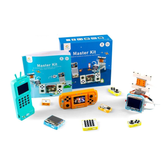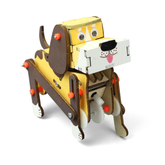-
951 Soldering Flux Pen951 Soldering Flux Pen Soldering Flux Pen is the perfect solution for electronic enthusiasts and professionals alike. It is precision-engineered with advanced flux technology, ensuring optimal soldering results. Made with premium materials, this flux pen is suitable for various conditions, making it perfect for...
- Rs. 139
Rs. 199- Rs. 139
- Unit price
- per
Save Rs. 60 -
Noel Silicone Spray 425mlNoel Silicone Spray 425ml Noel Silicone Spray (425ml) is a high-quality lubricant designed to reduce friction in machinery, molds, plastic finished goods, and other products facing friction issues. Formulated with premium silicone oils, this spray ensures smooth operation and extends the life of mechanical...
- Rs. 189
Rs. 249- Rs. 189
- Unit price
- per
Save Rs. 60 -
Noel 100W/230V Solder PotNoel 100W/230V Solder Pot The Noel 100W/230V Solder Pot is a high-quality, durable soldering and desoldering tool designed for efficient performance. Made with a titanium plate and high-grade stainless steel, it offers excellent resistance to high temperatures, acids, and abrasion. The non-stick tin coating...
- Rs. 1,299
Rs. 2,349- Rs. 1,299
- Unit price
- per
Save Rs. 1,050 -
Soldron Solder Wire DispenserSoldron Solder Wire Dispenser An excellent accessory to go with Soldering irons and Soldering Stations, the dispenser takes the trouble out of dispensing solder wire and can be used for small and frequent jobs as well as constant soldering work. Solder Reel Stand Handy heavyweight...
- Rs. 218
Rs. 299- Rs. 218
- Unit price
- per
Save Rs. 81 -
Soldron Bit-Tip Tinner And CleanerSoldron Bit-Tip Tinner And Cleaner A revolutionary product Soldron Bit-Tip Tinner And Cleaner available for the first time in India only from Soldron, this product is ideal to re-tin your de-tinned Soldron bits for a much longer life and efficient use. It is also an...
- Rs. 589
Rs. 749- Rs. 589
- Unit price
- per
Save Rs. 160 -
SOLDRON Tripod PCB Holder and ClampSOLDRON Tripod PCB Holder and Clamp Exclusively designed by SOLDRON for use by professionals who want a clean and accurate soldering. This product will hold your PCB steadily in place while you solder accurately and efficiently.
- Rs. 525
Rs. 649- Rs. 525
- Unit price
- per
Save Rs. 124 -
Soldron Tweezer and Cutter Pouch SetSoldron Tweezer and Cutter Pouch Set 6 various size and type ESD safe stainless steel tweezers and cutter in a Soldron branded canvas pouch. The ultimate tweezer set to ensure you get the positioning of your components just right. Also useful for jewellers due...
- Rs. 1,062
Rs. 1,391- Rs. 1,062
- Unit price
- per
Save Rs. 329 -
Soldron Hot Air Blower for 878D and 740 Stations- BL500ASoldron Hot Air Blower for 878D and 740 Stations- BL500A Spare Hot Air Blower exclusively for 878D and 740 Stations An ergonomically pleasing and in built air blowing mechanism, allows for a small size and efficient method of delivering hot air to any relevant application. The hot...
- Rs. 2,999
Rs. 3,499- Rs. 2,999
- Unit price
- per
Save Rs. 500 -
12V DIY Spot Welder Machine PCB Circuit Board Kit12V DIY Spot Welder Machine PCB Circuit Board Kit The Faraday 12V DIY Spot Welder Kit is a compact and efficient spot-welding solution designed for makers, hobbyists, and battery-pack builders. Built on a single-chip microcomputer system, this portable spot welder provides stable performance, strong...
- Rs. 1,169
Rs. 1,899- Rs. 1,169
- Unit price
- per
Save Rs. 730 -
Multicolor Handheld Spot Welding Pen for 18650 Battery – Automatic Trigger DIY Welding ToolMulticolor Handheld Spot Welding Pen for 18650 Battery – Automatic Trigger DIY Welding Tool This handheld spot welding pen is designed to make 18650 battery welding quick, precise, and effortless. Built with a thick copper bar, it delivers strong conductivity and high working efficiency,...
- Rs. 1,299
Rs. 1,649- Rs. 1,299
- Unit price
- per
Save Rs. 350 -
Basic Soldering Iron Tip Holder StandBasic Soldering Iron Tip Holder Stand The Basic Soldering Iron Tip Holder Stand is a practical accessory designed to safely hold a hot soldering iron during use. Made with a sturdy metal coil and stable base, it helps prevent accidental burns and protects your...
- Rs. 0
- Rs. 0
- Unit price
- per
for additional 5% discount! + Redeem RC COINS 👇






























